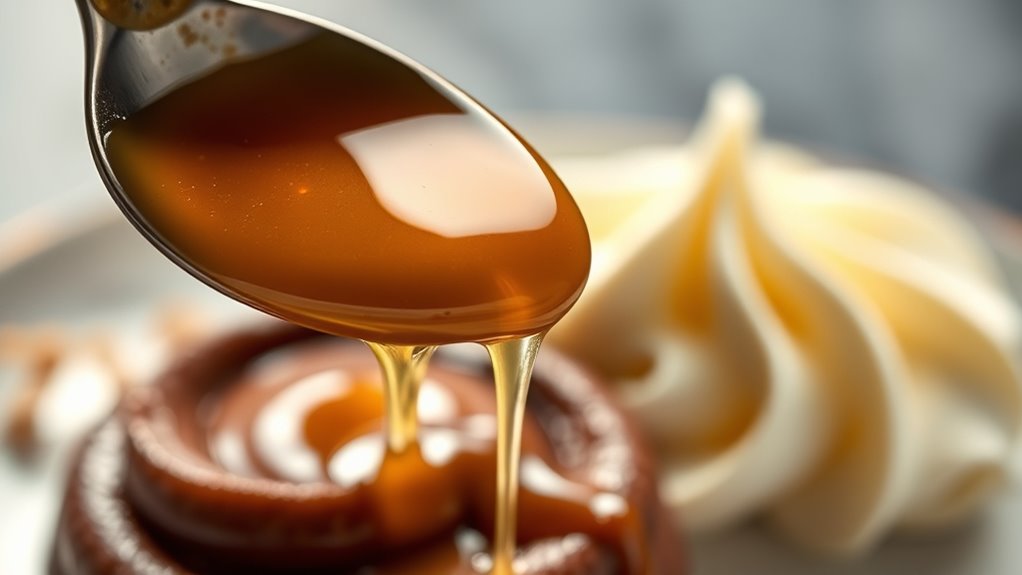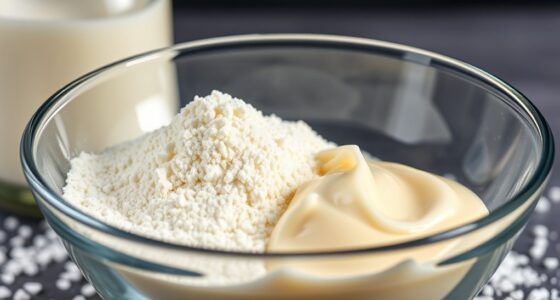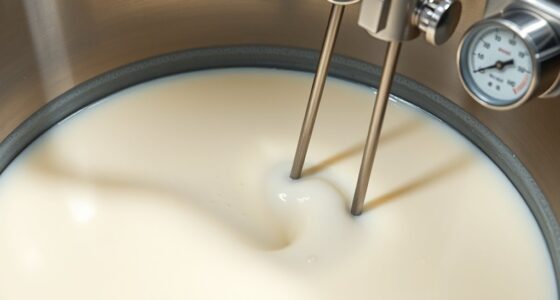Fat and sugar are key flavor carriers that influence your taste and aroma experiences. Fat helps trap and slowly release aromatic compounds, making flavors more persistent and mouthfeel smoother. Sugar enhances sweetness, interacts with taste receptors, and balances other flavors, enriching the overall profile. Both substances facilitate molecular interactions that integrate aroma and taste signals into a unified sensory experience. Keep exploring to discover how these carriers shape your favorite foods’ flavor complexity.
Key Takeaways
- Fat traps aromatic compounds, enhancing aroma release and creating a richer, more nuanced flavor profile.
- Sugar interacts with taste receptors, intensifying sweetness and balancing overall flavor perception.
- Both fat and sugar facilitate molecular interactions, aiding in aroma delivery and sensory integration.
- Fat influences mouthfeel, adding smoothness and creaminess that affect flavor perception.
- Sugar modulates flavor release and viscosity, enhancing overall taste complexity and palatability.

Flavor carriers are substances that deliver and enhance taste and aroma in food and beverages. When you take a bite or sip, these carriers work behind the scenes, influencing how you perceive flavors by interacting with your senses on a molecular level. Fat and sugar are prime examples of flavor carriers, and their presence profoundly shapes your overall sensory experience. They do more than just add richness or sweetness; they actively participate in molecular interactions that affect how your taste buds and olfactory receptors interpret flavors. These interactions create complex sensory integration, where multiple signals combine to produce the perception of flavor.
Flavor carriers enhance taste and aroma through molecular interactions, shaping our overall sensory experience.
Fats, in particular, are exceptional at trapping and releasing aromatic compounds, which enhances aroma perception. They act as solvent carriers for hydrophobic molecules, allowing flavors that might otherwise escape your senses to linger longer in your mouth. This prolonged aroma release deepens your flavor experience and can even modify the way certain tastes are perceived. For example, fatty acids can bind to aromatic molecules, stabilizing them and enabling your nose to detect subtler notes. The molecular interactions between fat molecules and aroma compounds help create a richer, more nuanced flavor profile. Similarly, fats influence mouthfeel, adding a smooth or creamy sensation that amplifies the perceived intensity of flavors. This synergy between aroma and texture exemplifies sensory integration, where multiple sensory inputs combine to create a cohesive, satisfying experience.
Sugar also functions as a flavor carrier, but in a different way. It enhances sweetness and can mask undesirable tastes, but it also influences molecular interactions within the mouth. Sugar molecules interact with taste receptors on your tongue, intensifying sweetness through their specific receptor binding. These interactions can modulate the perception of other flavors, making them seem more balanced or prominent. Sugar’s role extends to affecting the viscosity and overall texture of foods, which further influences sensory integration. When sugar dissolves, it alters the way flavors are released and perceived, often heightening the overall sensory impact. This is why sweet foods tend to feel more satisfying—they engage multiple sensory pathways simultaneously, creating a harmonious flavor profile.
Ultimately, both fat and sugar serve as essential flavor carriers that facilitate molecular interactions crucial for flavor perception. By acting as media for aroma compounds and modulating taste receptor activity, they help your brain integrate these signals into a unified sensory experience. Your perception of flavor isn’t just about individual tastes or smells; it’s a complex process that involves the seamless integration of multiple sensory inputs. Understanding how these carriers work illuminates why certain textures and sweetness levels make foods more appealing, as they optimize sensory integration at the molecular level to deliver a more immersive and enjoyable flavor experience.
Frequently Asked Questions
How Do Fat and Sugar Levels Vary Across Different Cuisines?
You’ll notice that fat and sugar levels vary widely across cuisines, shaping regional flavor profiles. For instance, Mediterranean dishes often feature healthy fats and moderate sugar, while American and Asian cuisines may use higher amounts of sugar and fats to enhance taste. Cultural dietary habits influence these variations, reflecting local ingredients and traditions. By understanding these differences, you can better appreciate how flavor profiles are crafted to suit regional preferences.
Can Flavor Carriers Be Used to Reduce Sugar or Fat Content?
Think of flavor carriers as your secret weapon, much like a wizard’s spell. You can use flavor carrier formulation and sensory enhancement techniques to boost flavor perception while reducing sugar or fat. These carriers deliver intense taste and aroma, making lower-fat or lower-sugar foods more appealing. By honing these techniques, you enhance the eating experience without relying on high fat or sugar content, satisfying cravings healthily.
What Role Do Artificial Flavor Carriers Play in Processed Foods?
Artificial flavor carriers, through flavor encapsulation, enhance processed foods by improving carrier efficacy. They help lock in flavors, making them more persistent and vibrant, even with reduced fat or sugar content. This means you get a fuller taste experience without extra calories. By efficiently delivering flavors, these carriers boost product appeal, enabling manufacturers to lower unhealthy ingredients while maintaining desirable flavor profiles that satisfy your cravings.
How Do Individual Differences Affect Flavor Perception With Fat and Sugar?
Your individual differences, like genetic variations and cultural influences, shape how you perceive flavors from fat and sugar. If you have specific genetic traits, you might find certain tastes more intense or appealing. Cultural background also plays a role, influencing your taste preferences and familiarity with certain flavors. These factors combine to create a unique flavor experience for you, affecting how you enjoy processed foods with fat and sugar.
Are There Health Implications Linked to Manipulating Flavor Carriers?
Manipulating flavor carriers like fat and sugar can impact your metabolic health, potentially increasing risks of obesity and diabetes if overused. It might also elevate addiction potential, making you crave more of the flavorful foods. You should be cautious about excessive intake, as these alterations can disrupt your body’s natural regulation and lead to long-term health issues. Moderation helps balance flavor enjoyment and your overall well-being.
Conclusion
Just as the myth of Pandora’s box unleashed unforeseen wonders, fat and sugar release hidden depths in flavor perception. They act as secret carriers, transforming simple ingredients into unforgettable taste experiences. By understanding their roles, you can craft dishes that captivate and delight. Remember, mastering these flavor carriers is like holding the key to a world of culinary magic—where every bite reveals a new, tantalizing secret waiting to be discovered.










